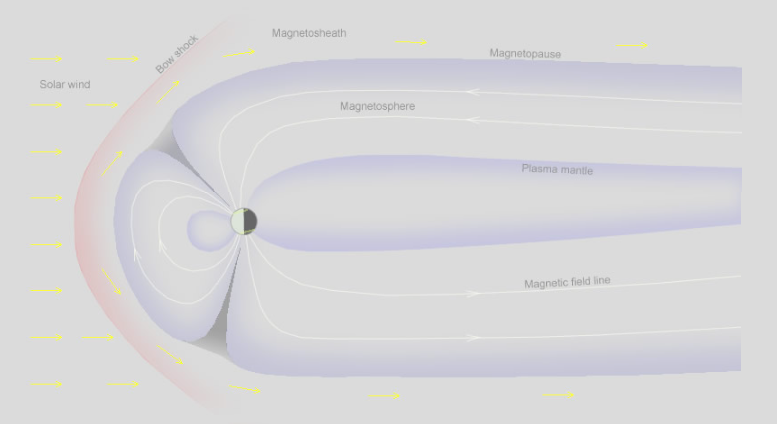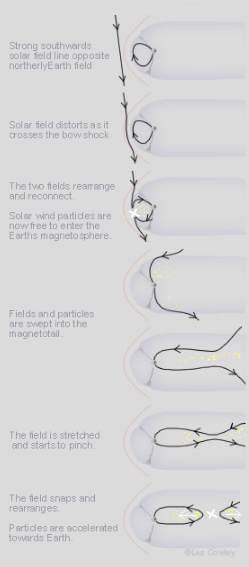Magnetosphere and aurora
Magnetosphere and Aurora: Exploring the Phenomena of Solar Wind Interaction
Have you ever wondered how the mesmerizing aurora lights are formed in the Earth's atmosphere? Contrary to popular belief, the particles from the sun alone do not directly collide with our atmosphere to produce these stunning displays. In fact, the process is much more intricate and relies on the combined magnetic fields of the sun and the Earth to trap and accelerate these particles. Let's delve deeper into the captivating relationship between the magnetosphere and aurora.
Unveiling the Solar Wind and its Composition
The solar wind is a continuous flow of particles, primarily ionized hydrogen (protons) and electrons, with a sprinkling of helium and heavier ions. These particles, known as the solar wind, are responsible for the creation of aurorae. However, on their own, these solar wind particles lack the necessary energy to generate visible aurorae. It is the interplay between the solar wind particles and the magnetic fields of both the sun and the Earth that produces this awe-inspiring phenomenon.
The Role of Solar Flares, Coronal Mass Ejections, and Coronal Holes
While the solar wind is constantly present, its intensity can be substantially amplified by solar flares, coronal mass ejections (CMEs), and coronal holes that are directed towards Earth. These celestial events act as catalysts, strengthening the solar wind and turning it into the true aurora makers. The enhanced solar wind carries not only particles but also the magnetism of the sun towards our planet.
Understanding Earth's Magnetic Field and its Distortion
Earth possesses its own magnetic field, which is generated by the rotating and turbulent outer core of molten iron. This magnetic field closely resembles that of a bar magnet at sea level. However, as we move away from Earth's surface, the influence of the solar wind and the sun's magnetism distorts the magnetic field.
The Dance Between the Solar Wind and Earth's Magnetic Field
As the supersonic solar wind approaches Earth, it encounters a shock wave known as the bow shock. This shock wave occurs where the solar wind first interacts with Earth's magnetic field and is abruptly slowed down. Inside the bow shock, the now subsonic solar wind particles flow around Earth's magnetic field, while the sun's magnetism remains trapped in the plasma and interacts strongly with it. This interaction causes the Earth's sunward magnetic field to be pushed inward, while the night side is stretched into a tail extending over a million kilometers. The region dominated by the sun's magnetism is called the magnetosheath, while the inner region governed by Earth's magnetism is known as our magnetosphere. The boundary separating these two regions is called the magnetopause.
Seeking Stronger Magnetic Interactions: Reconnections
In a steady wind from a calm sun, only a few particles manage to leak into the magnetosphere. However, to witness the breathtaking aurorae, stronger magnetic interactions are required. This is where reconnections come into play. When the trapped magnetic field of the sun points southwards, opposite to Earth's sunward field, and is reinforced by a solar flare or CME, it can strongly interact with Earth's field. The opposing fields snap and reconnect to a lower energy state. As a result, an open path is created through which solar particles can flow inside the magnetosphere.
The Journey of the Joined Sun-Earth Magnetic Field
The linked sun-earth magnetic field, still trapped within the moving solar wind plasma, continues its journey towards Earth's night side and into the tail of the magnetosphere. Here, the magnetic field becomes increasingly stretched, and the trapped particles fill a long inner tail called the plasma mantle.
The Final Twist: Aurora Formation
Another round of magnetic field reconnection or rearrangement ultimately leads to the formation of aurorae. The stretched field lines in the magnetotail become unstable, causing them to snap and rearrange into two regions. One region is controlled purely by Earth's magnetic field, while the other becomes part of the solar wind again. The part governed by Earth's field contracts rapidly, accelerating its trapped particles towards us.
The Spiraling Path of Trapped Particles
As the trapped particles accelerate towards Earth, they follow spiral paths along the magnetic field lines. Some of these particles contribute to the equatorial radiation belts, while others spiral along the field lines connecting the polar ovals. Eventually, these particles plunge into the upper atmosphere, creating the mesmerizing aurorae. Interestingly, due to the oscillation of some particles between the two ovals, the resulting Aurora Borealis and Aurora Australis appear as mirror images of each other.
The Varied Speeds of Solar Wind and Perturbations in Earth's Magnetosphere
The average speed of solar wind in Earth's orbital plane is approximately 400 km/s (or one million mph). However, variations occur, ranging from 300 km/s to 800 km/s. These speed fluctuations perturb Earth's magnetosphere, leading to diverse interactions between the solar wind and our planet's magnetic field.
The Influence of Solar Magnetic Field Directions on Reconnections and Aurorae
While reconnections can occur with solar magnetic field directions other than southward, a strong southward solar field is most conducive to these phenomena and subsequent aurorae.
In conclusion, the captivating dance between the solar wind and Earth's magnetic field gives rise to the enchanting spectacle of aurorae. The complex interactions between these cosmic forces result in the formation of vibrant lights that grace our night skies. By understanding the intricate mechanisms at play, we gain a deeper appreciation for the wonders of our atmosphere and the celestial influences that shape it.

Particles from the sun produce the aurora. They do not simply collide with Earth’s atmosphere to produce the glow, if they did we would not see many aurorae because on their own the solar wind particles are not energetic enough. Instead, the interaction is more subtle and involves the combined magnetic fields of the sun and the earth to trap and accelerate the particles.
The particles are mainly ionised hydrogen (protons) and electrons plus a few helium and heavier ions. This is the 'solar wind' and it flows continuously..
Solar flares, coronal mass ejections (CMEs) and coronal holes that are directed towards Earth substantially strengthen the solar wind and these are the real aurora makers.
The wind is a ‘plasma’, it is an overall electrically neutral mixture of positive and negatively charged particles. Plasmas trap magnetic fields and the solar wind carries not only particles to earth but also the sun’s magnetism.
Earth’s magnetic field, generated in its rotating and turbulent outer core of molten iron, is close to sea level like that of a bar magnet. Further out the impact of the solar wind and sun's magnetism distorts it.
The solar wind is supersonic and on Earth’s sunward side it produces a shock wave, the bow shock, where it first impacts Earth’s magnetic field and is abruptly slowed. Inside the bow shock the now subsonic wind particles flow around the earth’s magnetic field but the sun’s magnetism still trapped in the plasma interacts strongly. It pushes the Earth’s sunward field inwards and drags the night side out into a tail more than a million kilometres long. The region dominated by the sun’s magnetism is the magnetosheath. The inner region where Earth’s magnetism rules is our magnetosphere. The boundary is the magnetopause.
In the steady wind from a quiescent sun particles cannot get inside the magnetosphere. A few leak in but that is all. Aurorae need stronger magnetic interactions - reconnections.
When the sun’s trapped field points southwards.. it is opposite in direction to that of the sunward field of the earth. When strengthened by a flare or CME it can interact strongly with Earth's field. The opposed fields snap and reconnect to a lower energy state. The sun’s and earth’s fields are now linked and there is a hole in the sunward side of the magnetosphere - an open path through which solar particles can flow inside.
The joined sun-earth magnetic field is still trapped in the moving solar wind plasma and it is swept with its particles onwards to the earth’s night side and into the tail of the magnetosphere. There the magnetic filed is increasingly stretched and the trapped particles fill a long inner tail of the magnetosphere called the plasma mantle.
Another magnetic filed reconnection or rearrangement ultimately produces the aurora. The long stretched field of the magnetotail is unstable. The stretched field lines snap like elastic bands and rearrange to form two regions, one controlled purely by the earth’s field and one that is part of the solar wind again. The earth's part contracts rapidly accelerating its trapped particles towards us.
The final twist, or rather corkscrew, is that the trapped particles follow spiral paths around the magnetic field lines as they accelerate towards Earth. Some feed the equatorial radiation belts. Others spiral along field lines joining the polar ovals. These eventually plunge into the upper atmosphere to make aurorae. However, because the particle clouds in the contracting fields can equally go northwards or southwards along a field line connecting both ovals (and some particles oscillate between the two), the resulting Aurora Borealis and Aurora Australis are mirror images of each other.
. The average solar wind average speed in Earth's orbital plane is about 400 km/s (one million mph). Variations from 300 km/s up to 800 km/s occur and the speed variations perturb the earths magnetosphere.
.. Reconnections occur with other solar magnetic field directions. However, a strong southward solar field is best for them and subsequent aurorae.

Note: this article has been automatically converted from the old site and may not appear as intended. You can find the original article here.
Reference Atmospheric Optics
If you use any of the definitions, information, or data presented on Atmospheric Optics, please copy the link or reference below to properly credit us as the reference source. Thank you!
-
<a href="https://atoptics.co.uk/blog/magnetosphere-and-aurora/">Magnetosphere and aurora</a>
-
"Magnetosphere and aurora". Atmospheric Optics. Accessed on December 21, 2024. https://atoptics.co.uk/blog/magnetosphere-and-aurora/.
-
"Magnetosphere and aurora". Atmospheric Optics, https://atoptics.co.uk/blog/magnetosphere-and-aurora/. Accessed 21 December, 2024
-
Magnetosphere and aurora. Atmospheric Optics. Retrieved from https://atoptics.co.uk/blog/magnetosphere-and-aurora/.